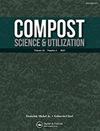Fingerprint of Exhaust Gases and Database of Microbial Diversity During Silkworm Excrement Composting
IF 0.9
4区 农林科学
Q3 ECOLOGY
引用次数: 2
Abstract
ABSTRACT Composting can convert silkworm excrement (SE) into good fertilizer, but the popularization of this practice is greatly hampered due to the strong odor produced. Determining the gas pollutants, the potential native aerogenic microorganisms and deodorant microorganism communities will lay foundations for developing good strategies to deal with malodor pollution from SE composting. This study qualitatively and quantitatively analyzed the exhaust gas and the microbial diversity. With a combination of solid-phase micro-extraction-gas chromatography tandem mass spectrometry technology and other methods of Chinese national standards, 43 odor pollutants from SE composting were identified and quantified. Ammonia, sulfur dioxide and hydrogen sulfide were the three major pollutants among the volatile inorganic compounds, with concentrations far exceeding the permissible standards for workplaces in China. 5-Ethyl-2,2,3-trimethyl-heptane, 2,2,4,6,6-5-methyl-heptane and 5-isobutyl-nonane accounted for 46.58% of volatile organic compounds. Using analysis of ribosome DNA sequences with Illumina Miseq PE 2 * 250, a next generation high-throughput sequencing technology, more than 694 bacteria (and actinomycetes) and more than 136 fungi were annotated, including groups of native aerogenic microorganisms and deodorant microorganisms. This study indicated a serious malodor problem and abundant microorganisms from SE composting and provided basic data not only for odor pollution control but also for future functional microorganism studies.家蚕粪便堆肥过程废气指纹图谱及微生物多样性数据库
堆肥可以将蚕粪转化为良好的肥料,但由于产生的强烈气味,这种做法的推广受到了极大的阻碍。确定气体污染物、潜在的天然产气微生物和除臭剂微生物群落,将为制定处理SE堆肥恶臭污染的良好策略奠定基础。本研究对废气和微生物多样性进行了定性和定量分析。将固相微萃取-气相色谱-串联质谱技术与中国国家标准的其他方法相结合,对SE堆肥产生的43种气味污染物进行了鉴定和定量。氨、二氧化硫和硫化氢是挥发性无机物中的三大污染物,其浓度远远超过中国工作场所的允许标准。5-乙基-2,2,3-三甲基庚烷、2,2,4,6,6-五甲基庚烷和5-异丁基壬烯占挥发性有机物的46.58%。使用下一代高通量测序技术Illumina Miseq PE 2*250对核糖体DNA序列进行分析,对694多种细菌(和放线菌)和136多种真菌进行了注释,包括天然产气微生物和除臭剂微生物。本研究表明SE堆肥存在严重的恶臭问题和丰富的微生物,不仅为恶臭污染控制提供了基础数据,也为未来的功能微生物研究提供了基础资料。
本文章由计算机程序翻译,如有差异,请以英文原文为准。
求助全文
约1分钟内获得全文
求助全文
来源期刊

Compost Science & Utilization
农林科学-生态学
CiteScore
4.10
自引率
0.00%
发文量
0
审稿时长
>36 weeks
期刊介绍:
4 issues per year
Compost Science & Utilization is currently abstracted/indexed in: CABI Agriculture & Environment Abstracts, CSA Biotechnology and Environmental Engineering Abstracts, EBSCOhost Abstracts, Elsevier Compendex and GEOBASE Abstracts, PubMed, ProQuest Science Abstracts, and Thomson Reuters Biological Abstracts and Science Citation Index
 求助内容:
求助内容: 应助结果提醒方式:
应助结果提醒方式:


